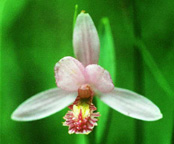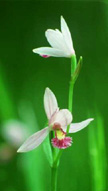Pogonia ophioglossoides (L.) Jussieu
Rose pogonia, Snake-mouth
The generic name Pogonia is derived from the Greek pogon,
for "beard", and refers to the "bearded appearance of the
labellum. The specific epithet ophioglossoides apparently refers
to the similarity between the leaves of this species and those of the fern
genus Ophioglossum. The genus Pogonia contains about 10 species,
distributed throughout East Asia, with only P. ophioglossoides being
found in North America.


DESCRIPTION: Plant glabrous, 15-35 cm tall, arising from
a cluster of fibrous roots, with runners or stolons from which other aerial
shoots arise. One leaf located midway up the stem, ovate to elliptical,
3-10 cm long and 1-2.5 cm wide; leaf somewhat fleshy in texture. Typically
one pink flower terminating the stem, rarely two or three, the flower
subtended by a elliptical to lanceolate foliaceous bract 1.5-4 cm long and
6-15 mm wide. Sepals pink, elliptical, 1.5-2.4 cm long and 2-5 mm
wide. Petals pink, elliptical, 1.5-2 cm long and 5-10 mm wide. Labellum
spatulate, 1.5-2 cm long and 5-10 mm wide; margin of the labellum fringed
with fleshy hairs, center of the labellum bearing several rows of similar
hairs, typically pink with marginal hairs darker pink-purple or magenta
and central hairs yellow, occasionally all pink or deep magenta.
SIMILAR SPECIES: The plants are difficult to identify unless flowering,
but then they can be confused with little else. Two slightly similar species
that grow in the same habitat and flower at about the same time are Calopogon
tuberosus and Arethusa bulbosa.
HABITAT: Pogoniais almost always found is acidic, boggy conditions,
typically growing from Sphagnum moss. In Wisconsin it can be most
commonly found growing in floating mat bogs ringing northern lakes. A second
common habitat is wet sphagnous swales in areas of sandy soils, such as
relic dunes along Lake Superior and in the region of Glacial Lake Wisconsin
in the west-central counties.
FLOWERING DATES: June 25-August 10.
POLLINATION: According to Thien &
Marcks (1972), Pogonia is pollinated by bumblebees. Like the
co-occurring Arethusa bulbosa and Calopogon tubersosus, the
pollination system of Pogonia is deceptive. While the flowers appear
attractive to the visiting bees, they supply no reward for pollination services
rendered.
DISCUSSION: Pogonia typically forms large diffuse colonies
as a result of its method of vegetative spread. Long, thin runners are sent
out from plants through the upper layers of Sphagnum. At intervals,
adventitious buds lead to the formation of new plants. This vegetative reproduction
also means that Pogonia lends well to cultivation, given the proper
environment. Carson Whitlow, of Cyp
Haven, sells propagated plants of Pogonia. As always, it is recommended
that you buy cultivated plants from a reputable source, rather than remove
them from the wild.
WI DISTRIBUTION:  U.S. DISTRIBUTION:
U.S. DISTRIBUTION:
Go directly to Wisconsin herbarium records.
Return
to the main LIST of the Orchids of Wisconsin.
Return to the main KEY to the Orchids of
Wisconsin.


 U.S. DISTRIBUTION:
U.S. DISTRIBUTION: